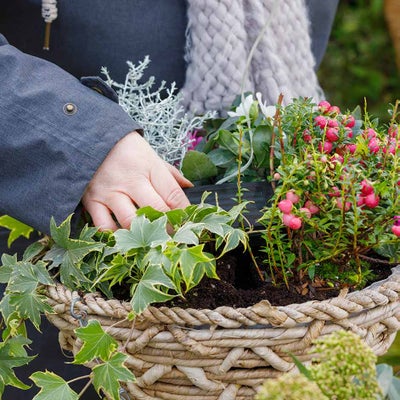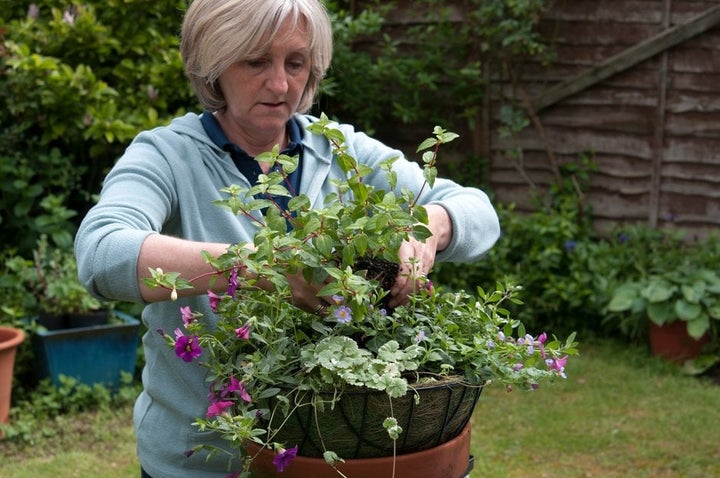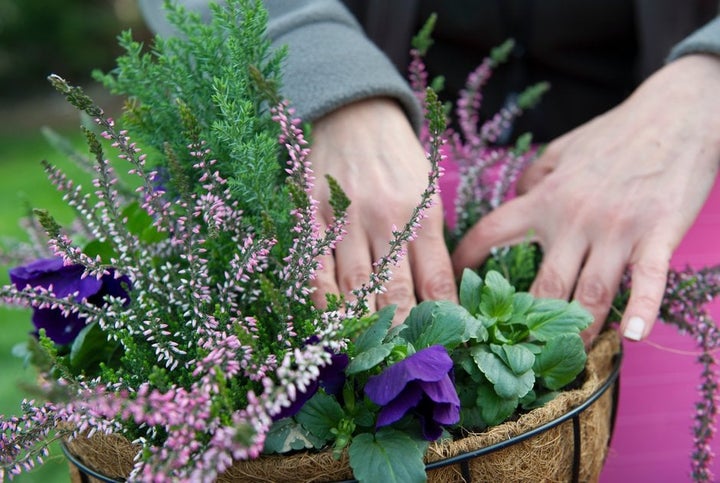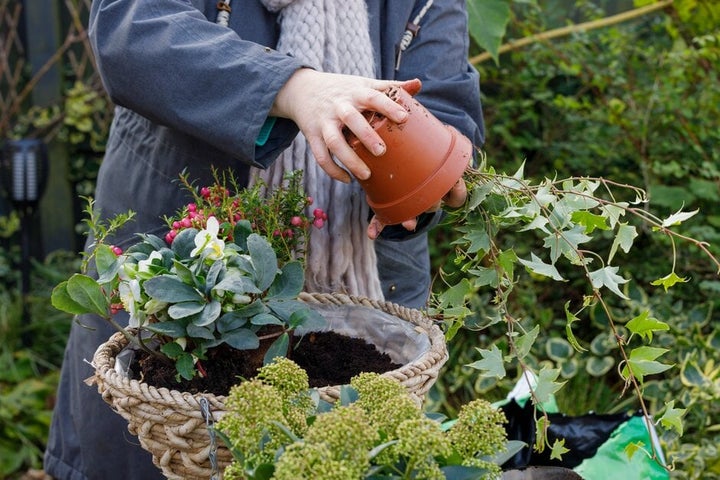
Quick facts
Summer and winter bedding plants provide seasonal colour, but with careful plant selection you can use hanging baskets for long term displays
Trailing plants positioned in the top of a hanging basket will soon spill over and cover the sides
Hanging baskets containing summer flowering annuals require regular watering, sometimes daily during hot, sunny weather
What to plant
For ideas on selecting plants for containers to provide seasonal interest, see our pages on summer and winter container plants. See below suggestions for plants suitable for baskets.
Plants for summer baskets:
Argyranthemum, Lysimachia nummularia (creeping Jenny), Dichondra ‘Silver Falls’, Pelargonium(geranium), Lobelia erinus, Petunia, Salvia and Nicotiana (tobacco plants), Glandularia, Helichrysum petiolare, and tumbling tomatoes.
Plants for winter baskets:
Crocus, Gaultheria, Irisreticulata cultivars, Hedera (ivy) – either or plain, Carex (ornamental sedge), Primula (primulas and polyanthus), Cyclamen (small-flowered cyclamen), Viola (winter pansies and viola) and Erica carnea (winter-flowering heathers).
Plants for baskets:
Hedera (ivy), Carex (ornamental sedge), Salvia officinalis and cultivars, Thymus (thyme), Heuchera, Hylotelephium cauticola, Sempervivum, Erigeron karvinskianus, and strawberries.
When to plant a hanging basket
Plant summer hanging baskets from late April onwards, but they will need protection from frosts until late May/early June. If you do not have a greenhouse, it is usually easier to plant your basket once the risk of frost has passed. Acclimatise tender to outdoor temperatures by hardening off.
Plant winter hanging baskets between September and November.
You would normally plant up a long-lasting hanging basket from April onwards, depending on the types of plants being used.



Preparing and planting a hanging basket
There are a few things to consider before you plant up your hanging basket:
Lining
First of all, if you are using a standard wire basket, it will need to be lined. You can buy ready-made cardboard liners and fibrous materials sold for the purpose, but a thrifty option is to collect moss from your lawn. Avoid buying sphagnum moss, unless you are sure it has been harvested from a sustainable source. If using moss, aim to cover the inside with a layer about 1.5cm (½in) thick.
Watering systems
Before you fill your basket with consider how you will water it. Hanging baskets tend to dry out more quickly than other types of container and water can easily be wasted from them.
If you have many baskets, you might consider using an automated watering system. Drip irrigation systems deliver water slowly and directly to the roots so there is less risk of wasting water. They can be used with timers but still need to be adjusted as the plants grow bigger and the weather changes. Most drip irrigation systems are designed for mains tap water use as they need very clean and pressurised water for the drippers to operate correctly.
Compost
A good quality, peat-free multipurpose compost is fine for a display that only has to last for one year. Adding some loam based compost, such as peat-free John Innes potting compost, will benefit long-term plantings, but be mindful of the additional weight it will add to your basket. If you want to grow plants that prefer acidic soil, such as winter flowering heathers, it is best to go for ericaeous compost; although Erica carnea and E. × darleyensis, and cultivars of them, are less fussy about pH levels.
Planting up your basket
The same method is used for planting up both summer and winter baskets. See our handy step-by-step guide for information on planting a hanging basket.
Aftercare
Watering frequency
Check baskets every day in summer, watering unless the is already moist. Drying out is an increasing risk as the plants grow and days remain warm or windy. An easy way to check if they need water is to gently lift or nudge the baskets to gauge how heavy they are. If they are really light, they need watering.
Try to avoid them drying out to the point where plants start to droop ('wilting point'), but if they do wilt, you can place a bucket underneath to capture the water that runs off and return it to the basket. This will save water and soluble nutrients that are needed for flowering.
Although baskets don’t dry out as quickly in winter, they still need regular checking. Aim to keep the compost moist but not soggy, and avoid wetting the foliage and flowers. See our guide to watering containers for further information.
Feeding
Summer and edibles benefit from occasional feeding with a liquid fertiliser in spring, summer and early autumn (April to September). Winter hanging baskets don't need feeding - it can encourage soft new growth that is easily damaged by frosts.
If you grow little shrubs or in your baskets, feed them annually in spring by adding a slow-release fertiliser.
Deadheading
Deadhead regularly to encourage a succession of flowers and prevent the plants’ energy going into seed production.
Problems
Most problems with hanging baskets are related to watering. If they are not flowering well it could be one of these causes:
- Underwatering. If becomes very dry, it is difficult to rewet. Keep the compost just moist by checking and watering regularly, adding water slowly so it seeps into the compost
- Overwatering. If you water until it runs out of the bottom of the basket, soluble that the plants need to flower will be washed out of the compost, as well as wasting water
- Feeding without sufficient watering. Plants roots can be damaged by liquid feed that is not diluted correctly, always follow the instructions on the pack. Water the basket first before using diluted feed
Winter hanging baskets benefit greatly from a sheltered, sunny spot. If the position is exposed, consider giving the basket some protection in the coldest weather. Use either a layer of , or sit the basket on a bucket in a cool greenhouse for just the worst days.
Watch out for insect damage from aphids, slugs, snails and vine weevil. Powdery mildews may be troublesome.








